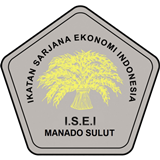PENILAIAN KEPUTUSAN INVESTASI SAHAM DALAM PENERAPAN INSENTIF PAJAK PENJUALAN ATAS BARANG MEWAH (PPnBM) BAGI PERUSAHAAN GO PUBLIC DI ERA PANDEMI COVID-19 (STUDI KASUS PADA PERUSAHAAN SEKTOR OTOMOTIF)
DOI:
https://doi.org/10.32400/jiam.5.1.2021.34272Keywords:
risk and return, CAPM, eficient market hypothesis, stock investment, tax incentive, PPnBM, Covid-19Abstract
In the midst of the Covid-19 pandemic, investors need to see and assess the level of risk to determine investment decisions. With various government policies, especially the Sales Tax Incentive on Luxury Goods (PPnBM), we can assess and compare the level of risk and risk before the issuance of this regulation, so that investors can make the best investment decisions in the midst of the Covid-19 pandemic. The stock beta for the automotive sector was still stable when the PPnBM incentive was implemented, as shown by the calculation of the CAPM Capital Asset Pricing Model, which is mostly below 1. The impact of the Covid-19 pandemic is still felt in world investment and tends to improve over time.References
Aliu, F., Pavelkova, D., & Dehning, B. (2017). Portfolio risk-return analysis: The case of the automotive industry in the Czech Republic. Journal of International Studies, 10(4), 72-83. https://doi.org/10.14254/2071-8330.2017/10-4/5
Bodie, Z., Kane, A., & Marcus, A. J. (2009). Investments, 8th Edition. New York: McGraw-Hill, Irwin.
Bollerslev, T., & Zhang, B. Y. B. (2003). Measuring and modeling systematic risk in factor pricing models using high-frequency data. Journal of Empirical Finance, 10, 533-558. https://doi.org/10.1016/S0927-5398(03)00004-5
Bora, B., & Adhikary, A. (2015). Risk and return relationship: An empirical study of BSE Sensex companies in India. Universal Journal of Accounting and Finance, 3(2), 45-51. https://doi.org/10.13189/ujaf.2015.030203
Brigham, E. F., & Ehrhardt, M. C. (2017). Financial management: Theory and practice, 15th Edition. United States: Cengage Learning.
Budiarso, N., & Pontoh, W. (2019). Does maturity signals high risk and high return?. Indonesia Accounting Journal, 1(1), 1-5. https://doi.org/10.32400/iaj.25404
Cloninger, D. O., Waller, E. R., Bendeck, Y., & Revere, L. (2004). Returns on negative beta securities: Implications for the empirical SML. Applied Financial Economics, 14(6), 397-402. https://doi.org/10.1080/09603100410001673621
Fahmi, I. (2015). Analisis laporan keuangan. Bandung: Alfabeta.
Fama, E. (1970). Efficient capital markets: A review of theory and empirical work. The Journal of Finance, 25(2), 383-417. https://doi.org/10.2307/2325486
Francis, J. C. (1991). Investments: Analysis and management. United States: McGraw-Hill.
Lakonishok, J., & Shapiro, A. C. (1986). Systematic risk, total risk and size as determinants of stock market returns. Journal of Banking and Finance, 10(1), 115–132. https://doi.org/10.1016/0378-4266(86)90023-3
Lintner, J. (1965). The valuation of risk assets and the selection of risky investments in stock portfolios and capital budgets. The Review of Economics and Statistics, 47(1), 13-37. https://doi.org/10.2307/1924119
Mossin, J. (1966). Equilibrium in a capital asset market. Econometrica, 34(4), 768-783. https://doi.org/10.2307/1910098
Pontoh, W., & Budiarso, N. (2019). Ipteks penghitungan risiko pasar dalam keputusan investasi. Jurnal Ipteks Akuntansi Bagi Masyarakat, 3(1), 1-8. https://doi.org/10.32400/jiam.3.1.2019.23302
Ross, S. A., Westerfield, R. W., Jaffe, J. F., & Jordan, B. D. (2018). Corporate finance: Core principles & applications, 5th Edition. United States: McGraw-Hill Education.
Sharpe, W. F. (1964). Capital asset prices: A theory of market equilibrium under conditions of risk. The Journal of Finance, 19(3), 425-442. https://doi.org/10.2307/2977928
Tandelilin, E. (2001). Analisis investasi dan manajemen risiko, Edisi Pertama. Yogyakarta: BPFE.
Downloads
Additional Files
Published
Issue
Section
License
Authors who publish with this journal agree to the following terms:
- Authors retain copyright and grant the journal right of first publication with the work simultaneously licensed under a Creative Commons Attribution License that allows others to share the work with an acknowledgement of the work's authorship and initial publication in this journal.
- Authors are able to enter into separate, additional contractual arrangements for the non-exclusive distribution of the journal's published version of the work (e.g., post it to an institutional repository or publish it in a book), with an acknowledgement of its initial publication in this journal.
- Authors are permitted and encouraged to post their work online (e.g., in institutional repositories or on their website) prior to and during the submission process, as it can lead to productive exchanges, as well as earlier and greater citation of published work (See The Effect of Open Access).







